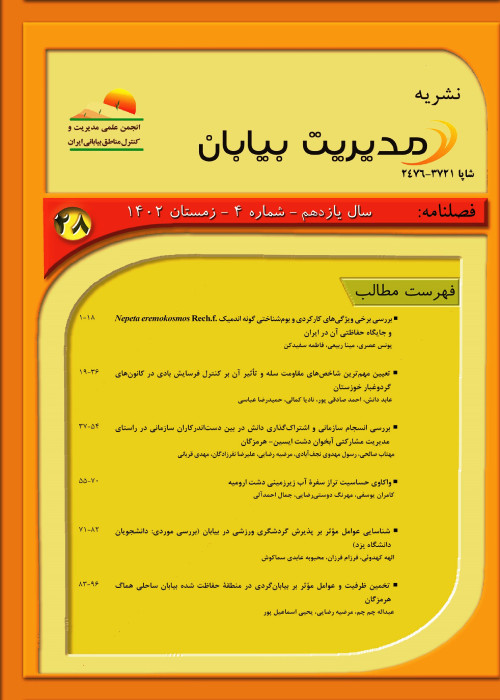Comparison of the Accumulation of Elements, Ash Content and Biomass of Some Halophytes Species under Irrigating with Sea Water
Author(s):
Article Type:
Research/Original Article (دارای رتبه معتبر)
Abstract:
To comparison biomass production, accumulation of some elements and ash content of shoots in five halophytes species including Salicornia bigelovii Torr., S. sinus persica, Atriplex lentiformis Torr., Halocnemum strobilaceum Bieb., and Halostachys caspica Botsch irrigated with seawater, a research was conducted at Salinity Research Station in Bushehr province. The results showed that there was a significant difference between the halophytes species in terms of concentration of Na+, K+, Cl-, Na+/K+ ratio, fresh weight, dry weight, shoot water content and ash. The highest and lowest Na+ concentrations were obtained in S. sinus persica and A. lentiformis species, respectively, whereas the rate of shoot Na+ in S. sinus persica was more than A. lentiformis by 101.3%. The highest concentration of K+, Cl- and Na+/K+ were obtained in leaves of A. lentiformis and shoots of two species of Salicornia and H. strobilaceum species, respectively. A. lentiformis with the production of 18.98 and 7.75 ton ha-1, had the highest fresh and dry biomass, respectively. The lowest fresh and dry biomass were also found in S. bigelovii by 10.13 and 2.49 ton ha-1, respectively. The highest and lowest ash content were related to shoots of S. sinus persica equal to 48.8% and leaves of Atriplex lentiformis equal to 37.5%, respectively. According to the results, Salicornia species has no mechanism of preventing salt entrance in the plant due to high concentration of Na+ and Cl- ions in their shoots. These species follow the mechanism of salt accumulation in plant tissues with the aim of osmotic regulation for survival in high saline conditions. Atriplex lentiformis also produced the highest amount of biomass, which could attributed to the low shoot water content of this species due to the presence of hard stems in the plant in comparison to the succulent stems and higher shoots water content in the other species. According to the production amount and ash content, it seems that A. lentiformis is a suitable species for forage producing in the regions with limited freshwater. Furthermore, Salicornia species could be also considered as part of a livestock diet in this regions.
Keywords:
Atriplex , Halocnemum , Halophyte , Halostachys , Salicornia
Language:
Persian
Published:
Desert Management, Volume:7 Issue: 14, 2020
Pages:
63 to 74
https://magiran.com/p2103314
دانلود و مطالعه متن این مقاله با یکی از روشهای زیر امکان پذیر است:
اشتراک شخصی
با عضویت و پرداخت آنلاین حق اشتراک یکساله به مبلغ 1,390,000ريال میتوانید 70 عنوان مطلب دانلود کنید!
اشتراک سازمانی
به کتابخانه دانشگاه یا محل کار خود پیشنهاد کنید تا اشتراک سازمانی این پایگاه را برای دسترسی نامحدود همه کاربران به متن مطالب تهیه نمایند!
توجه!
- حق عضویت دریافتی صرف حمایت از نشریات عضو و نگهداری، تکمیل و توسعه مگیران میشود.
- پرداخت حق اشتراک و دانلود مقالات اجازه بازنشر آن در سایر رسانههای چاپی و دیجیتال را به کاربر نمیدهد.
دسترسی سراسری کاربران دانشگاه پیام نور!
اعضای هیئت علمی و دانشجویان دانشگاه پیام نور در سراسر کشور، در صورت ثبت نام با ایمیل دانشگاهی، تا پایان فروردین ماه 1403 به مقالات سایت دسترسی خواهند داشت!
In order to view content subscription is required
Personal subscription
Subscribe magiran.com for 70 € euros via PayPal and download 70 articles during a year.
Organization subscription
Please contact us to subscribe your university or library for unlimited access!




